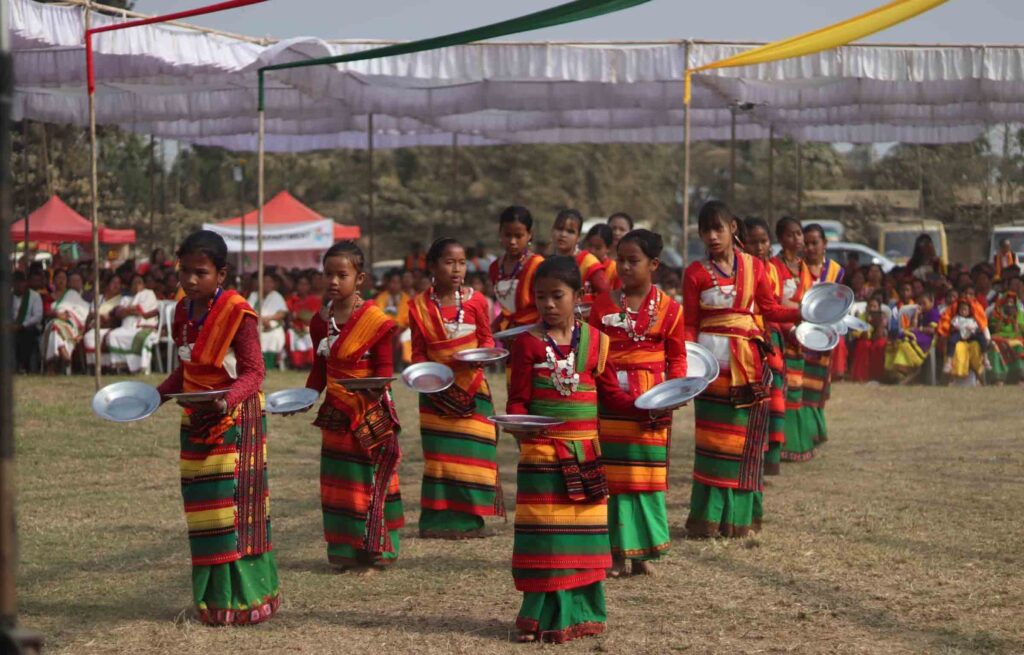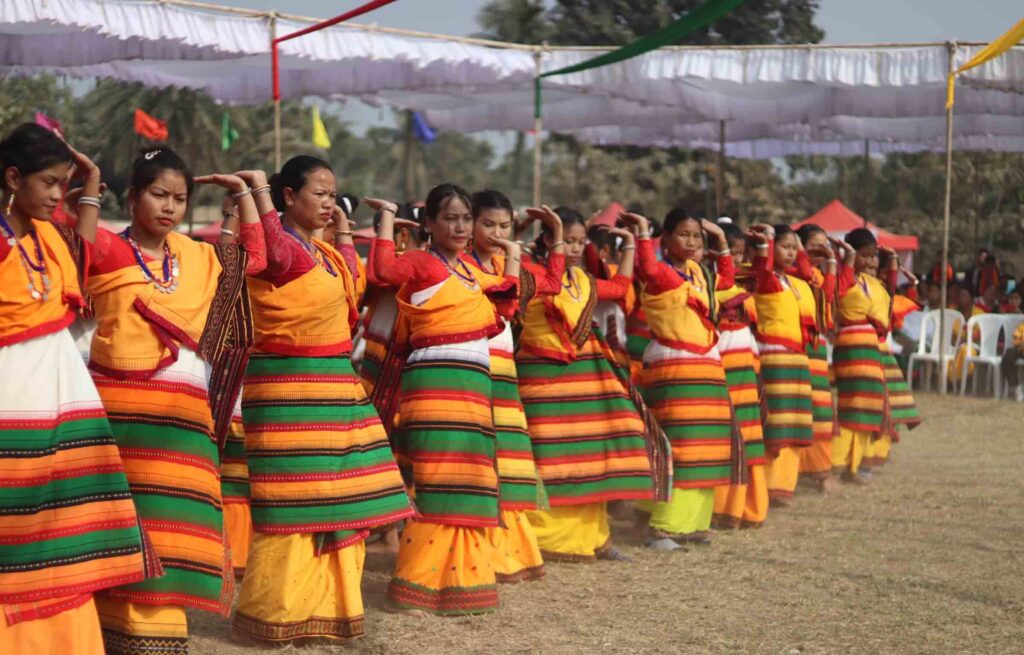
Dimasa communities across all Dimasa-dominated areas of Assam and Nagaland celebrated ‘Busu Dima,’ reflecting the age-old harmony among the simple and down-to-earth people of the region through their celebration of traditional food, sports, culture, and the festival of eating newly grown autumnal rice.
This celebration is often held when the jhum cultivation process is finished. As a result, the Busu is a time to unwind after a long week of work. In the Dimasa calendar, Busu Dima is among the most significant and huge celebrations.
Table of Contents
A Closer Look at Busu Dima Festival

The annual celebration of Busu Dima, Dima Hasao’s largest district festival, began on 27th January and will go on for another week.
The hill district of Dima Hasao and other dominated area of Assam and Nagaland celebrated the Bisu Dima celebration despite the cold. This event is also the post-harvest festival of the Dimasa.
Baidima is the name of the brilliant Dimasa dance, and on the day of their much-touted Busu Dima, residents of Dimasa-dominated districts in adjacent Cachar, Karbi Anglong, Nogaon, and Dimapur also congregated in great numbers to participate.
Cultural activities and public forums were held in various parts of Haflong, where speakers discussed the significance of Busu Dima (where “Busu” means “Bihu” and “Dima” means “Dimasa”) for the Dimasa people.
The Dimasas are a joyful people, and celebration is important to their way of life and way of being.
The Borail hill was alive with the sound of music and dance as the Dimasas celebrated their annual festival. Dimasas dance, known as “Baidima,” is an intricate art form that is performed to instrumental music only.
All the dancers have to go on is the rhythm set by the khram (drum) and the muri (fife, a traditional Dimasa musical instrument).
Although while some people might think the music from the muri to be a little repetitive, there are distinct variances in the microtones that are used for the various dance forms.
Busu Dima will be centrally organized at the field on February 1, and cultural troops from various areas of the Barail range and neighboring districts will participate in the event.
The festival is quite popular among visitors to Haflong, which is the administrative center of Dima Hasao and is regarded as one of the most beautiful hill station in the state of Assam.
The major Busu Dima Festival is divided into these three types:

- Jidaap : Jidaap is a Busu festival that lasts for a couple of days.
- Surem Baino: Surem Baino is a Busu festival that is celebrated for a total of five days.
- Hangshu Busu: Hangshu Busu, which is celebrated for a total of seven days.
On the 27th of January, the Dimasa communities of Dima Hasao, Karbi Anglong, Cachar, and Nagaon in the state of Assam, as well as the Dimapur region of Nagaland, observed Busu Dima centrally with a variety of planned activities.
During all of the celebrations, they would traditionally make a “heih-ho” (also known as a Haoba) to serve as a marker for the important ceremonies and events.
In the evening, a competition known as “Baiba Badailaiba” (also known as a “dancing competition”) is held in the playground.
This competition consists of singing, dancing, and playing Dimasa musical instruments from the muri (fife).
One of the highlights of the festival is going to be listening to musicians play traditional Dimasa instruments.
People who love culture were mesmerised by the “Baidama” dance, which has been performed by hundreds of young Dimasa men, women, and boys and girls.
The final competition of traditional music and sports marked the end of the Busu Dima festival. It is important to note that Maibang, which is located in Dima Hasao, is a large area that is inhabited by Dimasa people.
Over the years, these hardworking, peace-loving villagers have lived in peace while staying close to other communities in the area, which is a sign of many different ideologies.
This includes giving their village a facelift and making it a model village with a standard way of running their social system, which represents a lot of different ideas.
Busu Dima was celebrated with a lot of enthusiasm in all the Dimasa villages of Haflong, including Dibarai, Johaya Rajee,Digrik, Town Rajee, Boildura, and Gdain Rajee.
Conclusion
In conclusion, Assam and Nagaland’s Dimasa people celebrate the Busu Dima Festival. It’s a time to celebrate our traditional food, sports, and culture, including the autumnal rice festival.
After a long week of effort, the festival celebrates the end of jhum cultivation. The “Baidima” Dimasa dance, performed to instrumental music, is part of the festival.
The Busu Dima festival is popular with Haflong visitors. The festival ended with traditional music, sports, and the “Baidima” dance by hundreds of Dimasa men, women, boys, and girls.
The region’s simple, down-to-earth residents celebrate the festival as part of their way of life.
FAQs
What is the Busu Dima Festival?
The Busu Dima Festival is a traditional festival celebrated by the Dimasa People of Dima Hasao and other Dimasa Tribe dominated areas of Assam and Nagaland. The festival is celebrated annually in the month of January and February.
Where is the Busu Dima Festival celebrated?
The Busu Dima Festival is primarily celebrated in the town of Haflong and in all rural and urban areas of the Dima Hasao District of Assam, India. It is also celebrated in other Dimasa-inhabited areas such as Cachar, Karbi Anglong, and Nagaland.
What is the Baidima dance?
The Baidima dance is a significant part of the Busu Dima Festival of Dimasa tribe of Assam. It is performed by young Dimasa men and women, who dress up in traditional attire and dance to the beats of the drums and other musical instruments.
What are the different types of Busu Dima celebrations?
The major Busu celebration is divided into these three types:
1. Busu Jidaap : Jidaap is a Busu festival that lasts for a couple of days.
2. Surem Baino : Surem Baino is a Busu festival that is celebrated for a total of five days.
3. Hangshu Busu: Hangshu Busu, which is celebrated for a total of seven days.
Thank you so very much for highlighting our harvesting festival 🙏
This message, is matchless)))